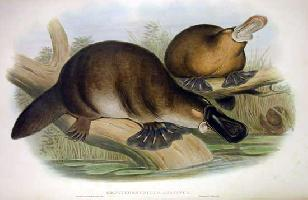
Starea de conservare
| Disparut |
Descrierea animalului
The Riversleigh platypus, scientifically named Obdurodon insignis, is an extinct species of monotreme that once inhabited the ancient waterways of Australia. This fascinating creature is a distant relative of the modern-day platypus (Ornithorhynchus anatinus), sharing many of its unique characteristics but also displaying significant differences that set it apart within the evolutionary history of monotremes.Obdurodon insignis is known primarily from fossilized remains discovered in the Riversleigh World Heritage Area in Queensland, Australia, a site renowned for its exceptionally well-preserved fossils that offer a window into the country's ancient past. These fossils date back to the Miocene epoch, approximately 5 to 15 million years ago, a period during which Australia's landscape and climate were vastly different from today.
The physical appearance of Obdurodon insignis would have been somewhat similar to that of the modern platypus, with a streamlined body adapted for an aquatic lifestyle. Its limbs were likely webbed, aiding in swimming, and it possessed a broad, flat tail that would have been used for propulsion and maneuvering through the water. One of the most distinctive features of Obdurodon insignis, as with all platypuses, was its duck-like bill. However, unlike the soft, flexible bill of the modern platypus, which is rich in electroreceptors for detecting prey underwater, the bill of Obdurodon insignis was harder and more robust, suggesting differences in feeding behavior or prey selection.
A particularly intriguing aspect of Obdurodon insignis is its teeth. While adult modern platypuses are toothless, using gravel and plates to grind their food, Obdurodon insignis retained functional teeth throughout its life. These included large, sharp molars, which would have been capable of crushing hard-shelled aquatic invertebrates such as crustaceans, a likely staple in its diet. The presence of teeth in this ancient species provides important clues about the evolutionary transition from toothed to toothless platypuses.
The size of Obdurodon insignis was another feature that distinguished it from its modern counterpart. It was significantly larger, with estimates suggesting it could have been up to 1 meter in length, nearly twice the size of the modern platypus. This larger size implies that Obdurodon insignis may have had fewer predators and occupied a different ecological niche within its ancient environment.
Despite the wealth of information gleaned from its fossil remains, many aspects of the life and behavior of Obdurodon insignis remain a mystery. Its breeding habits, social structure, and full range of habitats are subjects of ongoing research and speculation. What is clear, however, is that Obdurodon insignis represents a fascinating chapter in the evolutionary story of monotremes, offering insights into the adaptability and diversity of life in Australia's ancient ecosystems.
In summary, the Riversleigh platypus, Obdurodon insignis, was a remarkable creature that combined familiar aspects of the modern platypus with unique features that have long since vanished from the natural world. Its fossils serve as a testament to the rich and varied tapestry of life that has existed on Earth, reminding us of the constant change and evolution that shape our planet's biological heritage.
Animale similare
Fotografii noi cu animale
Top 10 animale
- Dolphin gull (Leucophaeus scoresbii)
- Diana monkey (Cercopithecus diana)
- Moustached guenon (Cercopithecus cephus)
- Galápagos tortoise (Geochelone nigra complex)
- Stone loach (Barbatula barbatula)
- Greek tortoise (Testudo graeca)
- Japanese macaque (Macaca fuscata)
- Russian tortoise (Testudo horsfieldii)
- Common flying dragon (Draco volans)
- Galápagos penguin (Spheniscus mendiculus)
